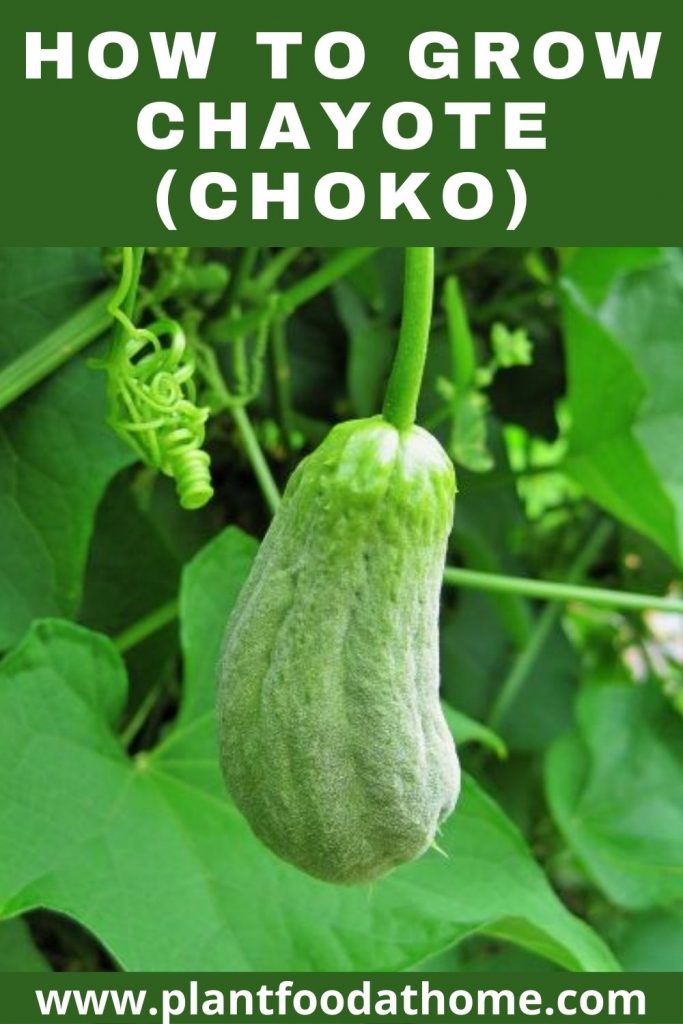Find out how to grow chayote squash as we cover planting, caring for, and harvesting chayote at home. Chayote is a prolific producer when grown in the right conditions and a popular vegetable to grow in a survival garden, food forest, or just an urban vegetable garden, so let’s find out how.
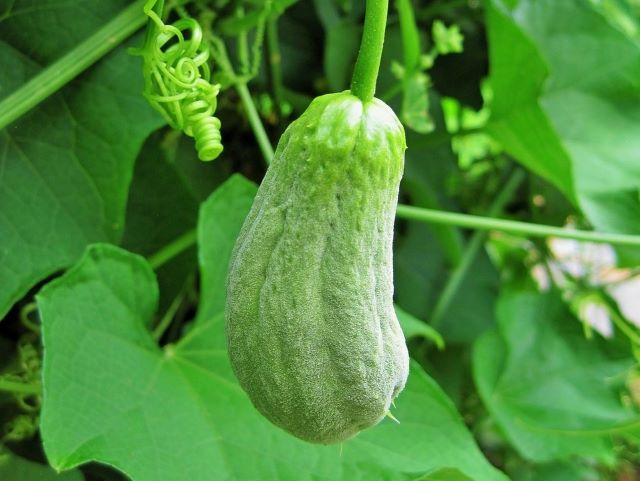
Table of Contents
- Chayote Squash Plant Profile
- Chayote Squash Varieties
- Ideal Growing Conditions for Chayote Squash
- How to Plant Chayote Squash
- Chayote Support and Trellis ideas
- Overwintering Chayote Squash
- Companion Plants for Chayote Squash
- How Long Does It Take a Chayote Squash to Produce Fruit?
- When and How to Harvest Chayote Squash
- How to Eat Chayote Squash
- Recipes Using Chayote Squash
- Storing Chayote Squash
- Common Pests and Diseases
- Conclusion
- Some Favorite Gardening Products
Chayote Squash Plant Profile
Chayote (Sechium edule) is an edible plant that comes from the Cucurbitaceae family or the gourd family. It is commonly known as choco, mirliton, pipinola, vegetable pear, custard marrow, and choko.
The most common chayote varieties are pear-shaped, with thin, wrinkled, and coarse skin texture. Its size ranges from 4-8 inches (10-20 cm). Chayote has one largish seed inside similar to an avocado.
While technically chayote is a fruit, it is most often cooked and treated like a vegetable.
Chayote vines are prolific fruiters and generally, one vine is more than enough for a family of four. Grown in the right conditions, you can expect 50-100 chayote fruit during the growing season.
The taste of chayote is mild in flavor similar to a potato, cucumber, and most similar to zucchini or summer squash.
Chayote is a perennial climbing vine that reaches as high as 39 ft (12 meters) when there is adequate support provided for it to climb. It has green, heart-shaped leaves and tendrils on the stem, with small and light green flowers.
Chayote Squash Varieties
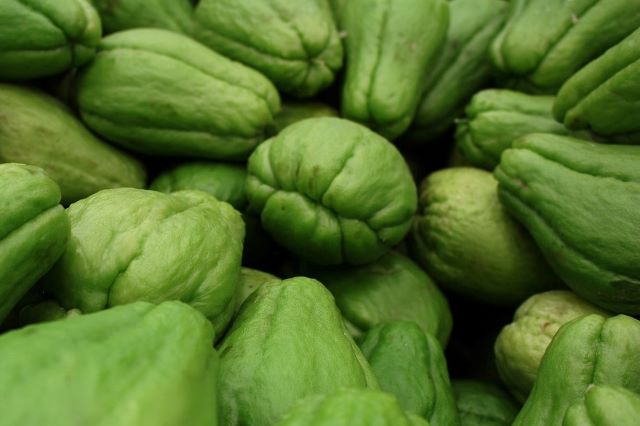
There are two main types of chayote; the wild chayote and the common cultivated one we normally plant in the garden or purchase from farmer’s markets or grocery stores.
The wild types of chayote grow near rivers, streams, and in other damp areas, and are often found in ravines. They are very similar to that of the cultivated type but they are more vigorous growers and the leaves, flowers, and fruits are larger. The wild fruit also differs in texture, color, and taste.
Chayote de Caballo – similar to the common cultivated chayote. Its fruit is often prickly and ridged (but can also be smooth). This variety has a good storage life.
Chayotillo – is also closely related to the common cultivated chayote and is considered a disease resistant for cultivated chayote. However, this is a rare type of chayote.
Cabeza de Chango – is also an uncommon variety that only grows in a small area of Mexico. This variety is similar to chayote de caballo.
Perulero – is a variety that belongs and is primarily cultivated in Guatemala. The fruit color ranges from light yellow to white.
Ideal Growing Conditions for Chayote Squash
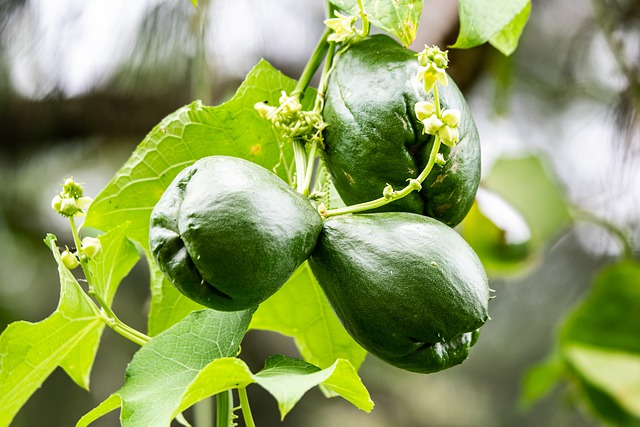
Chayote, like the other members of the gourd family, is sprawling in nature and requires sufficient more to grow. Although it is an easy-to-grow plant, it will do best in its ideal growing conditions, covered below.
Climate for Chayote Squash
Chayote thrives well in warm weather and grows best in tropical and subtropical regions. Start planting chayote 3-4 weeks after the last frost date in spring. It requires 120-150 frost-free and warm days for the fruits to survive until harvest. The soil temperature should be at least 65°F (18°C).
In the US, chayote grows well in zones 7-10. Outside of these zones, chayote can still be grown as an annual as long as the climate will be warm enough for the fruit to develop over the 120-150 days growing time.
Soil for Growing Chayote Squash
Chayote requires loose and well-drained soil, that retains moisture and is rich in organic matter. You can prepare the soil prior to planting with well-rotted manure and compost.
The ideal soil pH ranges from 6.0 to 6.8.
If you are in an area with high rainfall, it’s best to plant chayote in a sloping area to allow water drainage.
Watering Chayote Squash
Chayote needs plenty of water, especially in warm weather. Depending on the natural rainfall in your area, aim to water your chayote 2-3 times a week during summer and less in the cooler months. A deeper watering once a week may be enough in cool weather.
Younger chayote will require more regular watering while it establishes.
Sunlight for Chayote Squash
Chayote grows best in full sun. In arid climates, it will appreciate some afternoon part shade. So position your chayote vine where it will receive 6-8 hours of sunlight a day.
Fruits that are exposed to full sun have lighter yellow-green color, while plants grown under shaded areas will produce darker green fruits.
Fertilizer for Chayote Squash
The ideal fertilizer for chayote plants is an all-purpose organic fertilizer once like this one, every 6-7 weeks. It requires a little nitrogen, potassium, phosphorus, calcium, and magnesium during its growing period.
Additionally, a top dressing of compost around the plant in the middle of the growing season is beneficial.
How to Plant Chayote Squash
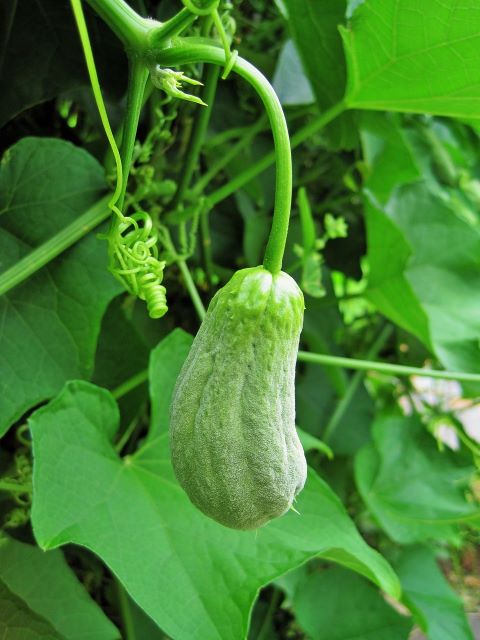
The seed of the chayote squash sprouts while still inside the fruit. Unlike most garden squashes, the entire fruit is usually planted and not just the seed.
Or you can plant the chayote directly into a pot following the steps below, before transplanting it out into the garden.
Planting Chayote Squash from Seed
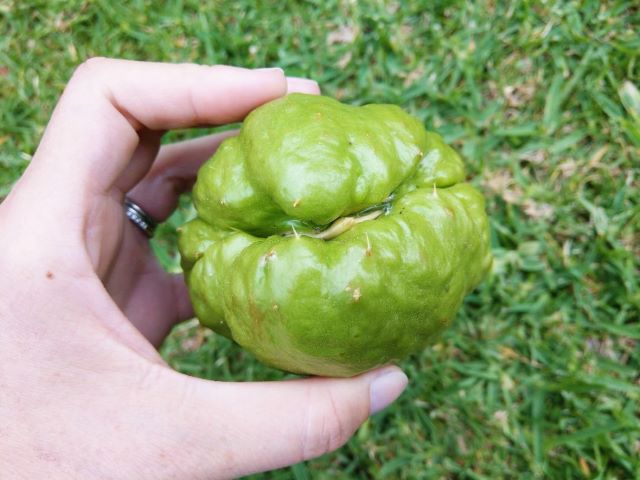
- Choose a mature chayote, unblemished with tough skin. Avoid using those that have started to go brown or rot.
2. You can begin the process by spouting the chayote, which can be exciting to see. Do this by placing the fruit in a cool, dry, place away from any moisture that could cause mold or rot. Wait until it starts to sprout which normally takes 3-5 weeks. Continue to wait until the sprout reaches about 2-4 inches (5-10cm) long.
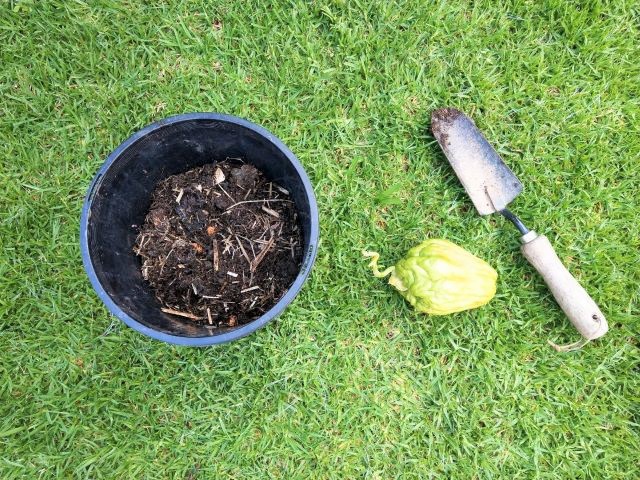
3. Fill a pot with moist organic potting soil like this one. Make a shallow hole at the center and place the chayote fruit with the sprout facing up. Position the fruit at a 45-degree angle.
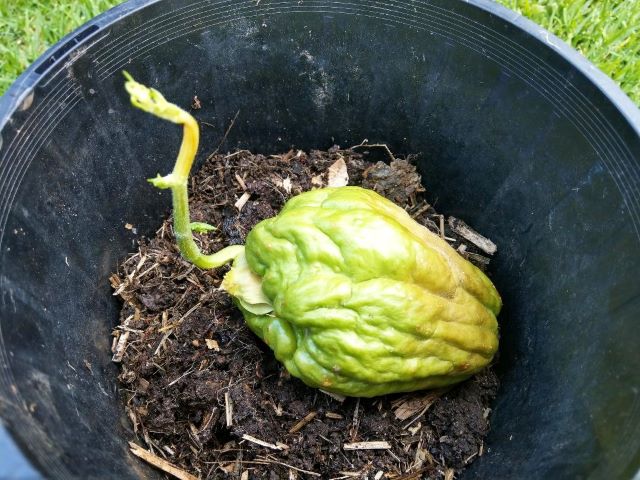
4. There is no need to bury the entire fruit, just gently firm the soil around it.
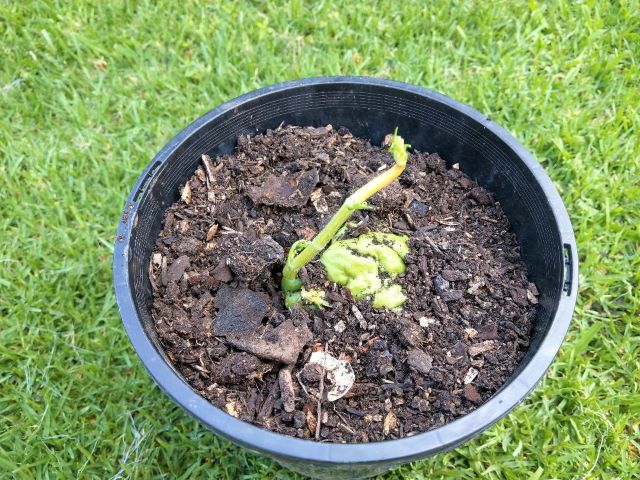
5. Place the pot in a warm, bright spot and water it. Then wait until the top inch of the soil dries out before watering again.
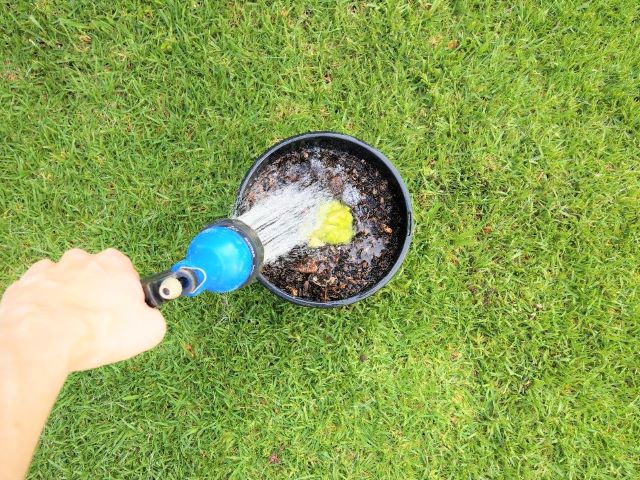
6. Once the plant is ready to be planted in the garden, prepare the soil with compost or manure.
7. Make sure to give the chayote vine plenty of space with at least 10 ft (3 meters) from other plants.
Note: You can also plant the chayote fruit directly in the garden. However, it is susceptible to rotting. So it’s a good idea to let it establish in a pot first before planting them in the garden.
Chayote Support and Trellis ideas
Chayote vines grow fast and long. They can reach up to 39 ft (12 meters) and so it needs great support to grow on.
When thinking of a trellis or support for chayote to grow on, consider structures such as walls, sheds, and fences, and also trees.
A tall trellis will help control the chayote vine and make harvesting the fruits easier. The trellis must be sturdy enough to carry the weight of the vine and the fruits.
Providing chayote with a tall trellis also prevents it from touching the ground. This will help you to stop any fallen chayote fruit. Once dropped chayote fruit touches the ground, it can begin to sprout and grow another vine.
Overwintering Chayote Squash
In cooler climates where chayote grows, it can be pruned to the ground and overwintered. At the end of the growing seasons, you can prune back the chayote vine to protect it from the cold including frost and some snow. Cut the vines back making sure they barely come out of the ground, then cover over with mulch. You can use fall leaves, pine needles or other types of mulch local to your area.
In a temperate climate, you can cut the vines back leaving a few shoots with about 6-8 inches (15-20 cm) in length. Chayote will then grow back with new shoots and vines in the spring when the weather warms up.
Mulching helps in preserving moisture and improves the condition of the soil. It is very beneficial for plants when it is done properly.
Mulch the chayote plant with a layer of 10-12 inches (25-30 cm), after harvest and before freezing temperatures start to kick in.
Companion Plants for Chayote Squash
Companion planting in the garden is the process of planting different crops in the same vicinity or area. There are different reasons for doing this including pest control, pollination, space maximization, providing habitat for beneficial insects, and or to increase crop production.
Plants that are great companions for chayote include squash, corn, peppers, pumpkin, passion fruit, and broccoli. Plants that are not advisable to be planted with chayote are mint, celery, and beans.
How Long Does It Take a Chayote Squash to Produce Fruit?
Chayote squash plants start flowering and fruiting after about 90 days from planting. This usually occurs during summer and fruit is ready by fall.
The chayote vine produces both male and female flowers that are pollinated through natural pollinators. Sometimes, hand pollination could be helpful especially if there is little pollination activity. You can do this by using a small soft paintbrush to transfer pollen from the male flowers onto the female flowers.
When and How to Harvest Chayote Squash
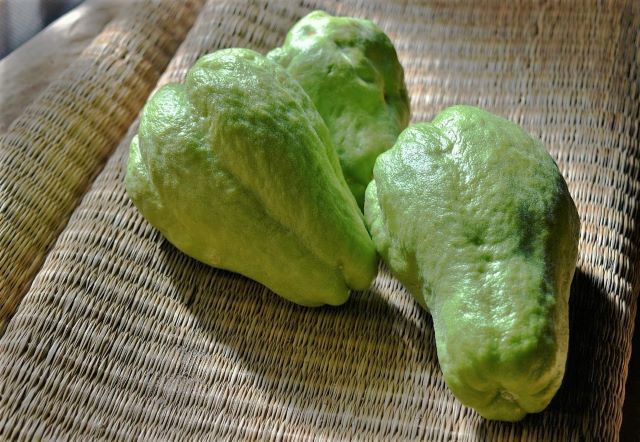
One chayote plant can produce many vines that yield as many as 50-100 fruits within its growing period. You will know when the fruit is ready for harvesting when they already reach about 4-8 inches (10-20 cm) in length and the skin changes color from dark green to a lighter green.
Gently pull the fruit off the vine, or cut the fruit using a knife or hand-pruners. Wear gloves when harvesting as the fruit has a sap that can irritate your hands.
How to Eat Chayote Squash
Most people are familiar with only the chayote fruit as being edible. But the root, stem, seeds, and leaves are edible as well. The shoots and leaves are often used in salads and stir-fries, while the fruit of the plant is eaten like potatoes and other root vegetables.
After picking, give them a wash, then cut it in half and remove the seed inside. Peel the skin on both halves of the flesh.
Chayote can be used in stews, they can be steamed, stir-fried, or substituted for apples and pears in pies.
Recipes Using Chayote Squash
Chayote can be eaten raw or cooked. Its firm and crisp texture make it the perfect choice for sautés and salads.
Below are some of the recipes around the world using chayote squash.
Sweet Stewed Chayote Fruit Recipe and Chayote Curry Recipe – our recipes.
Sautéed Chayote with Pork and Tomato
For more on eating chayote with more recipe ideas, you might like to see our article: How To Eat Chayote (Choko) With Recipe Ideas.
Storing Chayote Squash
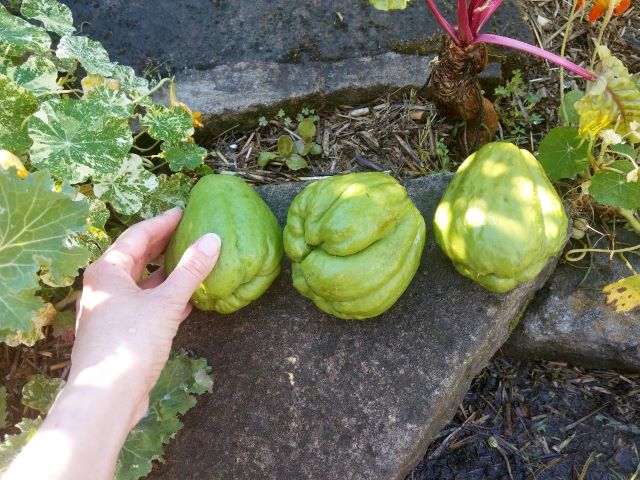
For storing chayote, choose the fruits that are evenly colored, firm, and blemish-free. The ideal storage temperatures are between 50°F-60°F (10°C -15.5°C). Below these temperatures, the chayote will likely show signs of cold damage.
To prevent moisture loss and the chayote turning dry during storage, place them in a sealed container or plastic bag in the refrigerator to maintain the humidity. This stores them well for up to a month. Check them every now and again for any signs of shriveling or brown spots.
Diced chayote can be frozen or canned for a longer shelf life of 12 months.
They can also be placed on newspaper and stored in a single layer in a cool, dry, and darkened room.
Common Pests and Diseases
Pests and diseases are not usually a big problem for chayote. However, those that do affect chayote are similar to those affecting squash and pumpkin.
The roots of chayote are sensitive to nematode. Melon fly can cause blemishes, but do not develop on the fruit.
Other insect pests include red spiders, coleoptera, moths, cucumber beetle, squash ladybug, aphids, and the squash vine borer.
Powdery mildew can affect chayote before reaching maturity if not managed. We have a DIY Milk Spray to manage powdery mildew here: Milk Spray Recipe For Powdery Mildew (Natural Fungicide for Plants).
Common diseases include Mycovellosiela cucurbiticola, and Ascochyta phaseolorum, which are more common in prolonged periods of rain.
High disease incidents have also been seen in the field with high nitrogen fertilization.
These pests and diseases can be managed, controlled, or prevented by using non-infected seeds or removing of the infected vine as soon as possible.
Proper spacing between plants can also help to encourage airflow, and treatments using suitable fungicides containing sulfur or potassium bicarbonate help eradicate these pests.
Conclusion
Chayote squash is one of the most interesting and productive plants to grow in the garden. It is easy to grow and a fast-growing vine. In fact, one plant can produce as many as 50-100 chayote fruits. This makes the chayote a staple crop to grow in any garden. And nothing beats the taste and quality of a freshly grown chayote!
Some Favorite Gardening Products
- Horticultural Neem Oil
- King Bird Raised Garden Bed
- Felco Garden Pruners
- AeroGarden Bounty Indoor Hydroponic Herb Garden
- Sloggers Waterproof Garden Gum Boots
Further Reading:
- Growing Zucchini: Planting, Caring, And Harvesting Zucchini
- 7 Causes of Dying Pumpkins with Solutions
- How to Grow Cucumbers: Planting, Growing and Harvesting
- Growing Pumpkins Successfully At Home
- How To Grow Okra: Planting, Caring, And Harvesting Okra
- Why Is My Asparagus Dying? Causes and Solutions
- Okra Dying? Common Causes and Solutions!
- Perennial Vegetables to Plant Once and Harvest Forever
